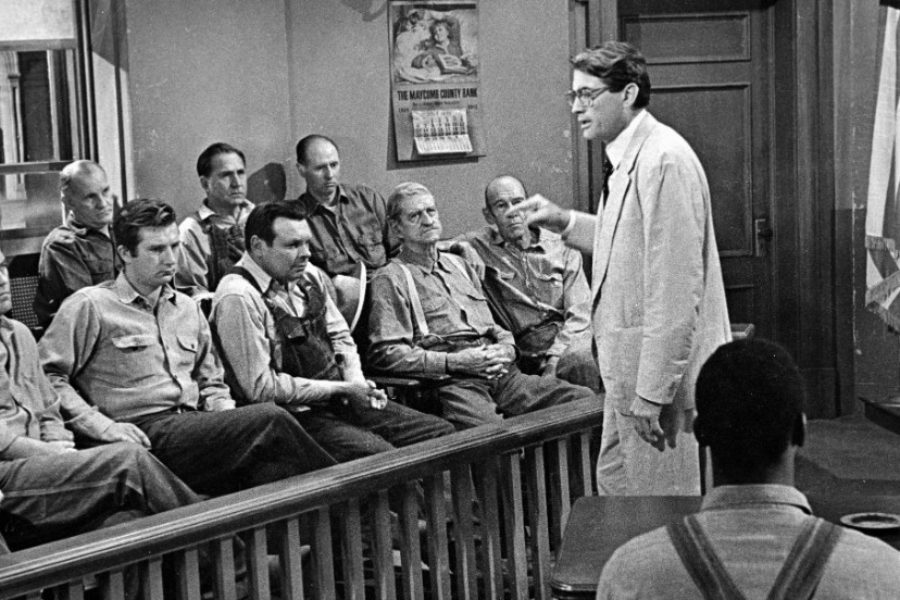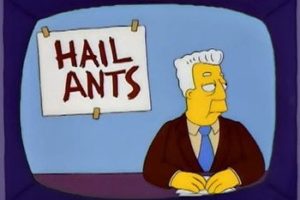Reproduced below is my latest and somewhat lengthy article on Roger Stone as it appears in The American Spectator. If you would like to read it complete with readers’ comments, you can access it on the AmSpec website by clicking this link.
The featured image above is from To Kill a Mockingbird. That’s Atticus Finch (Gregory Peck) summing up to the jury on behalf of his doomed client, Tom Robinson (the guy with his back to the camera). It’s an apt pictorial metaphor for what happened in USA v. Roger Stone.
Hope you enjoy the piece.
Whither Roger Stone? | The American Spectator
When O. J. Simpson was arrested following his notorious slow-speed Bronco chase, a local television news reporter interviewed the late and legendary A. Charles “Chuck” Peruto Sr., the dean of Philadelphia’s criminal defense bar. After summarizing the overwhelming mountain of incriminating evidence against Simpson, the reporter asked counsel how he would go about defending the case.
Chuck, a charming rogue and experienced courtroom lawyer, breezily brushed aside the damning evidence and confidently predicted that Simpson would be acquitted of all charges. When the astonished reporter asked him to explain, Chuck laughed and said, “Just look at the videotape of the Bronco chase and all those people hanging off the freeway overpasses waving and shouting, ‘Go, Juice, go!’ That’s your jury! No way are they going to convict Simpson.”
Chuck’s accurate prediction was based on the fact that, in any given trial, jury selection is the most critical phase, and central to the outcome of that process is the composition of the pool of potential jurors.
But as important as the process may be, many otherwise competent lawyers treat jury voir dire as an afterthought and fail to adequately probe the backgrounds, attitudes, and beliefs of the potential jurors. As a result, they often fail to eliminate those jurors who are predisposed to find any reason to go against their clients.
This is not to say that such a predisposition will necessarily result in a juror being stricken for cause. It frequently happens that, even if a venireperson expresses a strong belief that the defendant is guilty as charged, far too many judges will rehabilitate the juror by asking if he or she can nevertheless be fair and impartial. There are few, if any, people who would ever say that they can’t be fair. So the usual result is the juror following the judge’s lead by mechanically declaring that of course he or she can be fair and impartial. And that’s how a lot of judges handle voir dire.
It’s all a legal fiction and total nonsense, but that’s how it works in way too many courtrooms. Denied a proper challenge for cause, the defense must then consider using one of its limited number of peremptory challenges to get rid of the clearly biased juror.
The problem becomes particularly acute — if not insurmountable — when the number of demonstrably biased potential jurors exceeds that of the available peremptory challenges. Under those circumstances, the defense faces the bitter prospect of having to choose among clearly unsuitable venirepersons knowing that, once the peremptory challenges are used up, the jury will still be polluted by one or more similarly biased jurors.
Consider, for example, the daunting and miserable prospects faced by defense counsel in the trial of United States v. Roger Stone. That case was tried in the District of Columbia, where, in terms of the jury pool’s demographics, Stone was at a distinct disadvantage.
In 2016, Hillary Clinton won 90 percent of the D.C. vote compared to Donald Trump’s 4 percent. The major industry is the federal government, whose employees are overwhelmingly Democrat, as evidenced, for instance, by reports that Justice Department personnel contributed to Clinton’s campaign by a margin of 20 to 1. As for the remainder of the D.C. population, it is fair to say that most are in one way or another associated with or dependent upon the federal leviathan for their livelihoods.
And that was the major problem facing Stone’s lawyers. Their client was a well-known Republican political operative and associate of a despised president who has pledged to dismantle the hometown’s biggest employer. To paraphrase my old friend and courtroom adversary Chuck Peruto, “That’s your D.C. jury pool! No way were they going to acquit Roger Stone the Trump supporter!”
So, as far as jury selection was concerned, when Stone entered that Washington courtroom, he was a dead man walking.
Judge Amy Berman Jackson conducted the jury voir dire in two parts. First, on September 9, 2019, 120 potential jurors were summoned to the courthouse to answer under oath a written questionnaire. It covered each juror’s personal background, experience with the law and law enforcement, and availability for trial. It also contained a number of questions specifically designed to probe for potential bias.
Among these were questions related to the jurors’ knowledge of the trial participants and the case, how closely they had followed media reports about Stone, the House committee before which he had testified and its investigation into Russian interference in the 2016 presidential election, and the investigation by Special Counsel Robert Mueller.
The prosecution and defense were then provided with copies of the completed sworn questionnaires and given a week to file motions to strike potential jurors for cause based on their written answers. Stone’s lawyers filed under seal a list of “for cause” strikes which identified 54 jurors. Of these, Jackson struck 38.
On November 5, 2019, the remainder of the panel returned to court for voir dire, in which the judge and the lawyers questioned each potential juror individually and outside the presence of the rest of the panel. Each side was then allowed again to move to strike for cause.
On November 6, 2019, the parties exercised their peremptory challenges, after which the jury was seated and trial began. Stone was convicted on all charges.
In late 2019, Stone’s lawyers filed under seal a motion for a new trial in which they alleged that the court had improperly denied their request to strike one of the jurors for cause. According to the motion, that juror (whose name has been redacted) should have been removed because he/she is employed in a division of the IRS “that works hand-in-hand” with the Justice Department and because the juror “violated the Court’s order to avoid media coverage of the case.” According to the defense, this employment gave rise to an “implied” pro-prosecution bias.
In her February 12, 2020, order denying the motion, Jackson cited case law holding that trial courts “enjoy broad discretion in ruling on a motion for new trial” and that granting a new trial is warranted only in those limited circumstances in which “a serious miscarriage of justice may have occurred.” Jackson then picked apart counsels’ argument that, in effect, working for the IRS rendered one unfit for jury duty. She also noted that the juror had specifically denied in voir dire that working “for the government would affect [the juror’s] ability to be impartial in deciding the case.”
In ruling out the claim of juror bias, Judge Jackson cited case authority holding that determinations about juror impartiality frequently turn on the testimony of the juror in question. She pointed out that the “Court had the opportunity to observe the juror’s demeanor during voir dire, and it found then and finds now that the defendant has failed to show actual or inherent bias.” (Emphasis added.)
As for the juror’s knowledge of media reports, she cited case law that “qualified jurors need not … be totally ignorant of the facts and issues involved.… It is sufficient if the juror can lay aside his impression or opinion and render a verdict based on the evidence presented in court.” She also cited Supreme Court authority that the judge’s appraisal of the risk of juror prejudice “is ordinarily influenced by a host of factors impossible to capture fully in the [written] record — among them, the prospective juror’s inflection, sincerity, demeanor, candor, body language, and apprehension of duty.” (Emphasis added.)
Based on all of these factors, Jackson denied the motion for new trial.
But two days later, Stone’s lawyers filed a second motion for a new trial based on alleged misconduct by the foreperson of the jury. Previously this individual’s identity had not been made public. But that changed when the four prosecutors withdrew from Stone’s case (see my recent American Spectator article “Flight of the Drama Queens”) in apparent protest over the Justice Department’s filing of a supplemental sentencing memorandum withdrawing their previous recommendation that Stone be imprisoned for seven to nine years.
This prompted one Tomeka Hart to publicly announce that, as the foreperson of the Stone jury, she supported the prosecutors. “It pains me to see the DOJ now interfere with the hard work of the prosecutors,” she wrote. “They acted with the utmost intelligence, integrity and respect for our justice system.”
Conservative commentators and others promptly began reviewing Hart’s social media posts and comments. The astounding results demonstrated that Hart is a staunch Democrat party activist who ran for Congress in 2012 and has participated in anti-Trump rallies and protests. And, despite the fact in jury voir dire she testified under oath that she had only a slight passing knowledge of Stone, it has now been revealed that, on social media prior to trial, she mocked Stone’s arrest and labeled Trump and his supporters as racists.
On February 14, 2020, within 48 hours of these online discoveries, Stone’s lawyers filed the second motion for a new trial. Although the motion is under seal, it presumably is based on Hart’s newly discovered social media comments, which indicate a strong prejudice against Trump, his supporters, and, by extension, defendant Stone.
Since then, Harvard law professor Alan Dershowitz has tweeted that “All civil libertarians who care about non-partisan justice should support a new trial for Roger Stone based on this new information about a biased juror.” He was joined in those sentiments by Fox News’ Judge Andrew Napolitano.
It is far from certain, however, that Stone’s latest motion for a new trial will bear fruit. Even though it appears that Hart may have misled the court and counsel by her answers in voir dire, that alone does not warrant a new trial. Instead, it will be up to the defense to also establish that Hart’s purportedly misleading answers and presence on the jury resulted in a serious miscarriage of justice. To determine that, it would be necessary to question Hart under oath about her answers as well as her interactions with and influence on the other jurors.
If she was biased against Stone, did she share her views with the other jurors during the trial or deliberations? To answer those questions, it would also be necessary to question the other jurors.
But there are other issues that would also have to be addressed. For example, why are we just now learning about Hart’s strong prejudice against Trump and his supporters? The same social media postings found by the conservative commentators were available for review by counsel, who certainly had ample time and opportunity to investigate the backgrounds of everyone on the jury panel. But did they?
In the first phase of voir dire, Hart answered the written questionnaire. Her written answers remain under seal. But the transcript of her examination by the court and counsel starts with questions by the judge about Hart’s written answers.
As a result, we know that Hart disclosed in writing that she had a law degree, was not presently practicing law, and had never practiced criminal law. But according to the questionnaire, she had been the foreperson of a federal grand jury. Many weeks later, in answer to the judge’s follow-up questions, Hart stated that she had served for two years as foreperson of the grand jury in Tennessee. (Practice tip: this alone should have motivated defense counsel to get rid of her.)
Hart acknowledged that she understood that Stone was involved in Donald Trump’s presidential campaign, but said that would “absolutely not” affect her ability to be fair and impartial. She recalled “just hearing about [Stone] being part of the campaign and some belief or reporting around interaction with the Russian probe and interaction with him and people in the country, but I don’t have a whole lot of details. I don’t pay that close attention or watch C-SPAN.”
Hart responded affirmatively when the judge asked her if she could “wipe the slate clean and learn in this case from the evidence presented in the courtroom and no other source.”
Hart acknowledged that, as the judge put it, she “had some interest in Congress” but said that the “allegations of not being truthful to Congress” would not “make it hard for [her] to be fair.”
The prosecution had no questions.
When questioned by the defense, Hart stated that she had run for Congress and has friends who worked for members of Congress. When asked if she had “any political aspirations now,” she replied, “I don’t know. Not federal.”
Hart disclosed that she had served on the Memphis school board.
The judge then asked, “Is there anything about [Stone’s] affiliation with the Trump campaign and the Republican party in general that gives you any reason to pause or hesitate or think that you couldn’t fairly evaluate the evidence against him?”
Hart answered, “No.”
With that, the questioning ended, and the defense made no motion to strike for cause.
The following day, when the parties used their peremptory challenges, Hart was not stricken by the defense.
—
Now let’s hit the pause button and consider some key issues.
First, in the many weeks between Hart’s answers to the written questionnaire and her testimony in court, the defense had plenty of time to research the social media postings of every potential juror. Did defense counsel do so? If not, why not? If they were aware of Hart’s online comments, why did they neither question her about them, challenge her for cause, nor use a peremptory strike to eliminate her?
Although Hart may have lacked candor in her voir dire answers, competent counsel exercising due diligence could well have caught her in the act and successfully challenged her for cause or at the very least used a peremptory challenge to be rid of her. So it is that Stone’s sealed motion for a new trial may be based on a claim of ineffective assistance of counsel.
To establish such a claim, Stone would have to demonstrate that his lawyers’ handling of jury selection was professionally deficient, and, absent that deficiency, the outcome of the trial would have been different.
That’s a huge burden of proof.
In order for Jackson to give the motion the serious consideration it deserves, she would have to convene a hearing at which Stone’s lawyers would have to explain their voir dire strategy and decisions and how and why they failed to expose and strike Hart. In addition, Hart would have to explain her voir direanswers and be subjected to questioning about her conduct as a juror. And, as noted above, all of the other jurors will have to be questioned about any possible improper influence by Hart during the trial and deliberations.
Then the judge would have to decide whether or not Hart was, in fact, a fair and impartial juror. Recall that in denying the first motion for a new trial, Jackson cited the case law that provides that determinations about juror impartiality “frequently turn on the testimony of the juror in question.” She had the opportunity to observe Hart’s demeanor during voir dire and trial and would have the same opportunity during any hearing on the motion to observe and evaluate Hart’s “inflection, sincerity, demeanor, candor, body language, and apprehension of duty.”
Put another way, after the smoke clears, Jackson could find that despite Hart’s social media postings, she had been a fair and impartial juror. That would be the end of the motion for a new trial, and no appellate court would overturn any such finding of fact based on the trial judge’s personal observations.
Even if the judge found that Hart was not fair and impartial, then the next issue would be to what extent, if any, that influenced the outcome of the trial. In other words, would there have been a different outcome — say an acquittal — but for Hart’s participation?
There are a million other similar questions to be answered, but you get the idea. Roger Stone’s motion for a new trial is not a sure thing.
That’s the bad news. But the good news is that execution of Stone’s 40-month sentence of incarceration has been stayed pending a ruling on his motion. While the judge could conceivably deny the motion out of hand, she may well decide to conduct the hearings and allow for proper briefing of the issues and oral argument. If that happens, then Stone will remain free until the judge rules.
All of that will help use up the dwindling number of days before the 2020 election, after which Roger Stone’s legal prospects will brighten considerably.
George Parry is a former federal and state prosecutor. He is a regular contributor to the Philadelphia Inquirer and blogs at knowledgeisgood.net. He may be reached at kignet1@gmail.com.




Leave a Reply
Leave a reply.